Discover 7 hidden attractions, cool sights, and unusual things to do in Shepherdstown (United States). Don't miss out on these must-see attractions: Rumsey Hall, Packhouse Ford, and Shepherd's Mill. Also, be sure to include Shepherdstown Historic District in your itinerary.
Below, you can find the list of the most amazing places you should visit in Shepherdstown (West Virginia).
Table of Contents
Rumsey Hall
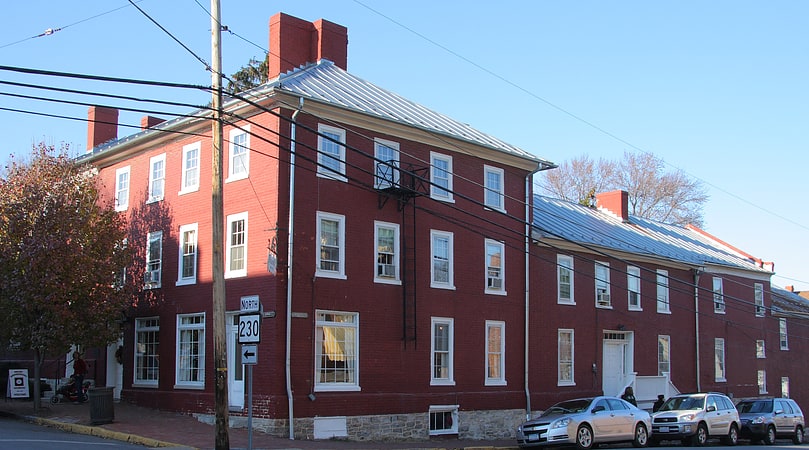
Building in Shepherdstown, West Virginia. Rumsey Hall, also known as the Entler Hotel, is an historic building in Shepherdstown, West Virginia. The building is located in the center of the Shepherdstown Historic District and is a composite of six separate phases of construction. The earliest portion was built in 1786, and was the home belonging to Christian Cookus. This section burned in 1912. This section was separated by a narrow passage from the core of the hotel property, first started in the 1790s by owner Daniel Bedinger. This Federal style structure was expanded to the corner sometime before 1809, with a further addition along Princess Street by 1815. A kitchen and a carriage house completed the complex. Significant interior features remain. In 1809 a store was opened in the corner building, operated by James Brown. At about the same time, the Globe Tavern opened, offering overnight accommodations. In 1815, Bedinger sold the property to James Brown and Edward Lucas for $6,000. In 1820 it was again sold, to Thomas Crown of Washington, D.C., for $4000. By this time the tavern was managed by Thomas James and the hotel by Daniel Entler. In 1823, Daniel Entler became the manager of the entire property. The Entlers managed the properties until 1873, when they moved to Piedmont, West Virginia, while retaining ownership of the hotel.
The Entler Hotel was one of two in Shepherdstown run by Entlers. Daniel Entler's brother Joseph ran the Great Western Hotel, and both were the sons of a German immigrant butcher and innkeeper from York, Pennsylvania.
The Entler Hotel was the chief venue in Shepherdstown for social events. After the Battle of Antietam, three miles away, Shepherdstown became a field hospital for the wounded, with many severely wounded brought to the Entler. On December 14, 1898, the Entler received one of the first two telephones installed in Jefferson County. Several fires occurred between 1899 and 1912, with a fire in 1910 killing the manager's daughter, who was playing with matches. In 1912 a conflagration burned several buildings on the north side of German Street, including the original Entler property. The hotel closed in 1917 and in 1921 it was sold to the State of West Virginia and became the first men's dormitory at Shepherd College, at which time its name was changed to Rumsey Hall. In the 1950s the building was used as faculty apartments, then as storage.
The Town of Shepherdstown bought the Entler from the State in 1978 after a bill was passed by the West Virginia Legislature that mandated that Shepherd College sell the building to the Town after a campaign to prevent the building's demolition, and began restoration work in 1982. The college was going to demolish the building and turn the property into a parking lot. The bill was sponsored by Delegates Clarence E Martin, III and Joseph Caudle. It is now used to house the Historic Shepherdstown Museum, office space for non-profit groups and for town meetings.[1]
Address: Corner of German & Princess, Shepherdstown
Packhouse Ford
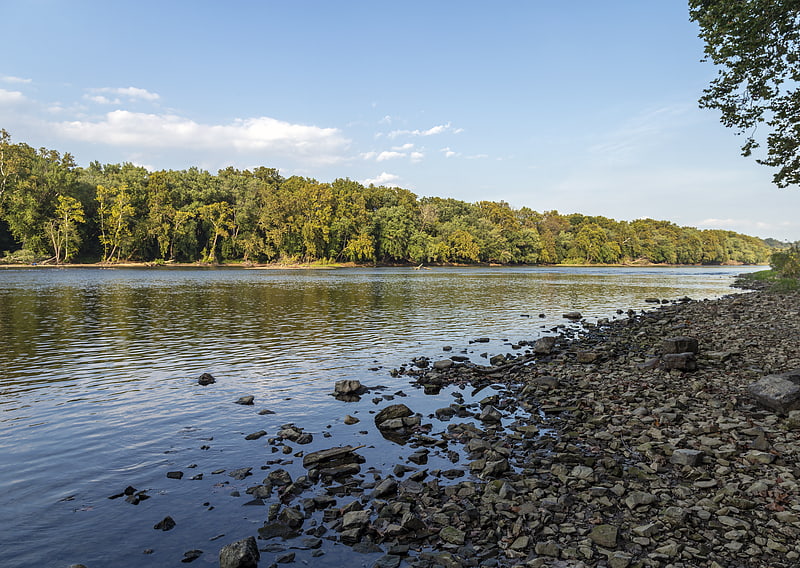
Packhouse Ford, also known historically as Pack Horse Ford, Blackford's Ford and Boteler's Ford, is a historic crossing point of the Potomac River. It is located about 1 mile east of downtown Shepherdstown, West Virginia, and south of Sharpsburg, Maryland, USA. The crossing was a Native American crossing site and eventually became a major crossing point in colonial times. During the American Civil War, it was used by military forces involved in the 1862 Battle of Antietam. The site of the ford is marked by a commemorative marker on the West Virginia side of the river, at the junction of River and Trough Roads.
The ford was listed on the National Register of Historic Places in 2015.[2]
Shepherd's Mill
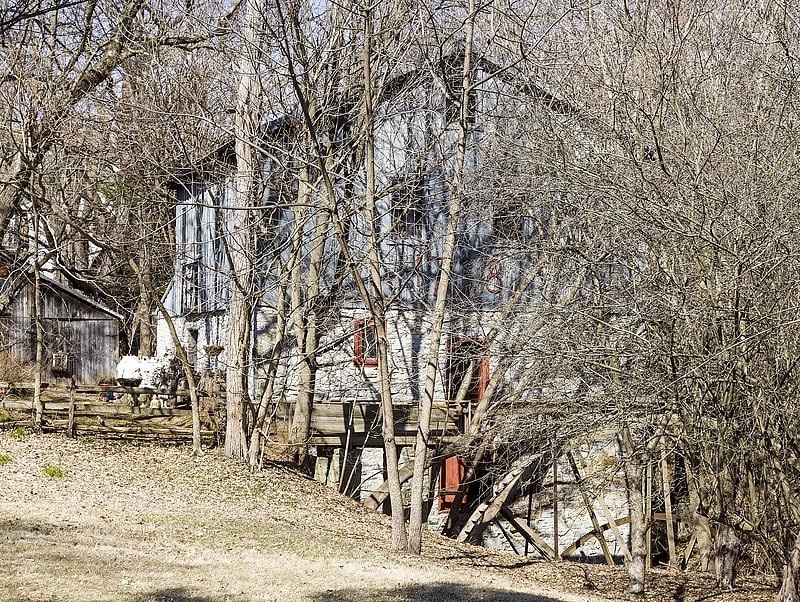
Mill in Shepherdstown, West Virginia. Shepherd's Mill is a gristmill in Shepherdstown, West Virginia, located on Town Run just as it descends to the Potomac River. The mill was built some time prior to 1739 by Thomas Shepherd, Sr. — founder and namesake of the town — as a two-story structure. The original millwheel was probably a wood overshot wheel. The present 40-foot-diameter Fitz Water Wheel Company steel overshot wheel was built in 1894; with the addition of a third story in the late 19th century, the mill is more representative of that era.[3]
Address: 301 N King St, Shepherdstown
Shepherdstown Historic District
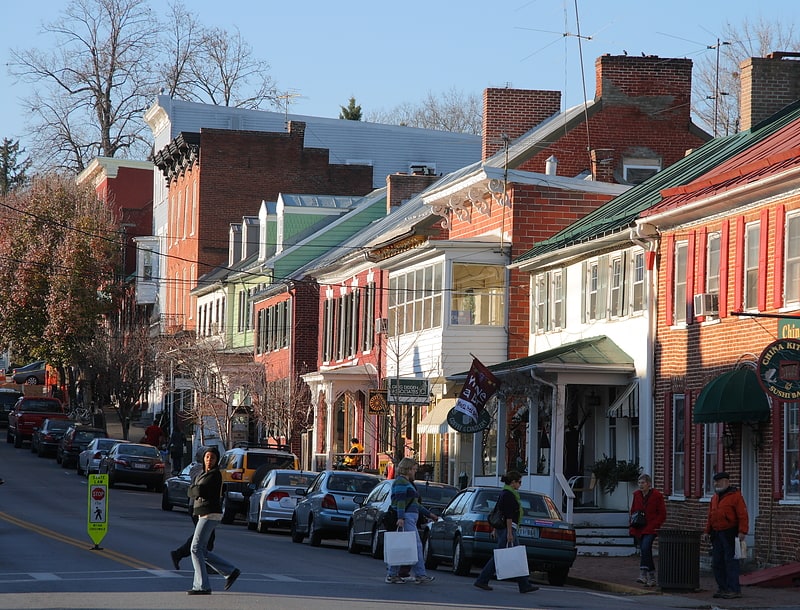
Historical landmark in Shepherdstown, West Virginia. The Shepherdstown Historic District comprises the historic core of Shepherdstown, West Virginia. The town is the oldest in West Virginia, founded in 1762 as Mecklenburg. No structures are known to exist from the time before the town became known as Shepherdstown. The historic district is concentrated along German Street, the main street, with 386 contributing resources and 69 non-contributing elements. The chief representative period is the late 18th century, with many Federal style brick houses. German Street is also furnished with 19th-century "street furniture" such as metal fences, mounting blocks, wooden pumps and mature trees.
The town has a significant place in American history. James Rumsey made a public demonstration of a steamboat in 1787 on the nearby Potomac River. Shepherdstown was proposed as the National Capital in 1790, losing to Alexandria, Virginia, and Georgetown, Maryland, at the tidal headwaters of the Potomac. During the Civil War, Shepherdstown was in a pivotal position, with Confederate forces burning the covered bridge over the Potomac in 1861, then using nearby Pack Horse Ford to and from the Battle of Antietam. The entire town became a field hospital following this action. Later, Union troops occupied the town to preserve the Baltimore and Ohio Railroad link to the west.
Some of the more significant elements are:
- Baker House, a Federal style brick house with a Roman Revival porch, dating to the 1790s. It was the home of US Representative John Baker.
- The Great Western Hotel, owned by Jacob Entler. Originally a log structure, it was extensively modified in the early 19th century.
- The Presbyterian Manse, a brick Federal style or Classical Revival house, home of John Kearsley, a prominent local landowner.
- Trinity Episcopal Rectory, a Federal style house that was a home of John Baker, as well as US Representative Thomas Van Swearingen.
- The Lane House, a Federal style house once owned by Harriet Lane, niece and hostess for President James Buchanan.
- The Sheetz House, a Federal style house where muskets were manufactured during the American Revolutionary War.
- The Old Market House, the town's former market built in 1800, with stepped gable ends. A second story was added in 1845 by the Odd Fellows with a 999-year lease. The first floor has been a public library since 1922.
- McMurran Hall, a yellow brick Greek Revival building in the Corinthian order, which served as the Jefferson County Courthouse immediately after the American Civil War. It was later the first building used by Shepherd College.
- The Entler Hotel, a thirty-two room complex, which is itself on the National Register of Historic Places.
- The Shepherd District Free School, a public school on the campus of Shepherd University, built in 1868.
- The Chapline-Shenton House, built in 1793 on the site of the original Sheetz gunnery, and bought in 1818 by Captain William Delyea, stepson of General William Darke. Congressman Van Swearingen lived in the house during the winter. During the Civil War the house was used as a hospital following the battle of Antietam.
- The Weltzheimer Tavern, which housed the Potowmac Guardian and Berkeley Advertiser in 1790, the first newspaper published in West Virginia. The newspaper was operated by Nathaniel Willis, grandfather of Nathaniel Parker Willis and a participant in the Boston Tea Party. In 1808 the building became known as Weltzheimer's Tavern.
- Shepherd's Grist Mill, itself listed on the National Register of Historic Places.
- Billmyer House, a Federal style house that served as an inn, and home of Col. John F. Hamtramck, a figure in the Mexican–American War.
The historic district was expanded in 1987 to include properties from the late 19th century, including the Register Building, the Opera House and the Jefferson Security Bank. The expansion also includes Elmwood Cemetery, with a large number of Civil War graves. Outer portions of the expanded district include American Foursquare and bungalow styles of housing. The older portions of the Shepherd University campus are also included.[4]
Address: German Street, Shepherdstown
Van Swearingen-Shepherd House
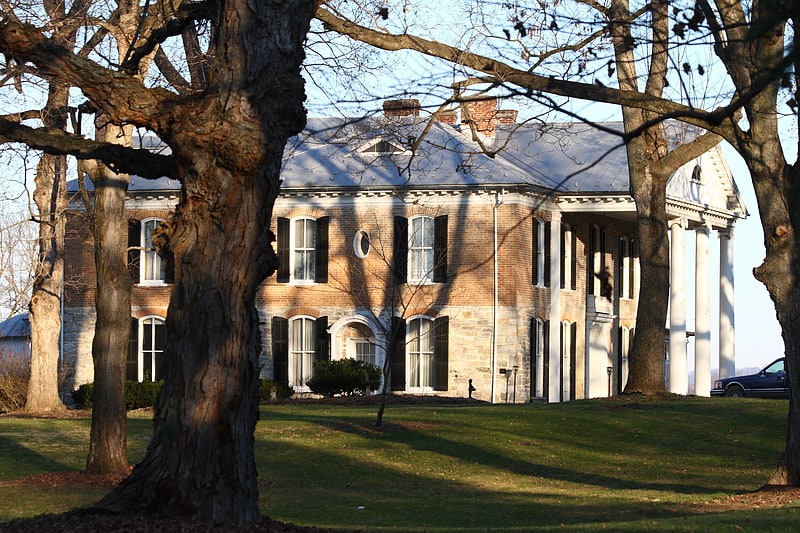
Mansion in Jefferson County, West Virginia. The Van Swearingen-Shepherd House, also known as Bellevue, is a Colonial Revival mansion in Shepherdstown, West Virginia that is home to the descendants of Captain Thomas Shepherd, founder of Shepherdstown. The house, situated on a bluff overlooking the Potomac River, was built in 1773 by Thomas Van Swearingen as a single-story stone house. His son, also named Thomas Van Swearingen, was a US Representative. The Shepherd family acquired the house in 1900, when Henry Shepherd III bought the house as a wedding present for his bride Minnie Reinhart, whose grandfather was Thomas Van Swearingen. That year, the Shepherds gave a dinner party on the lawn for William Jennings Bryan during his second presidential campaign. The house remains in the hands of the Shepherd family.
The original stone house has been extensively altered, with brick Victorian-era alterations exchanged for the present Colonial Revival style with a tetrastyle Ionic portico. The second story was added in the late 19th century, and all windows were converted to an arched pattern. In the early 20th century the Ionic portico was added by architect Stuart H. Edmonds.[5]
Conrad Shindler House
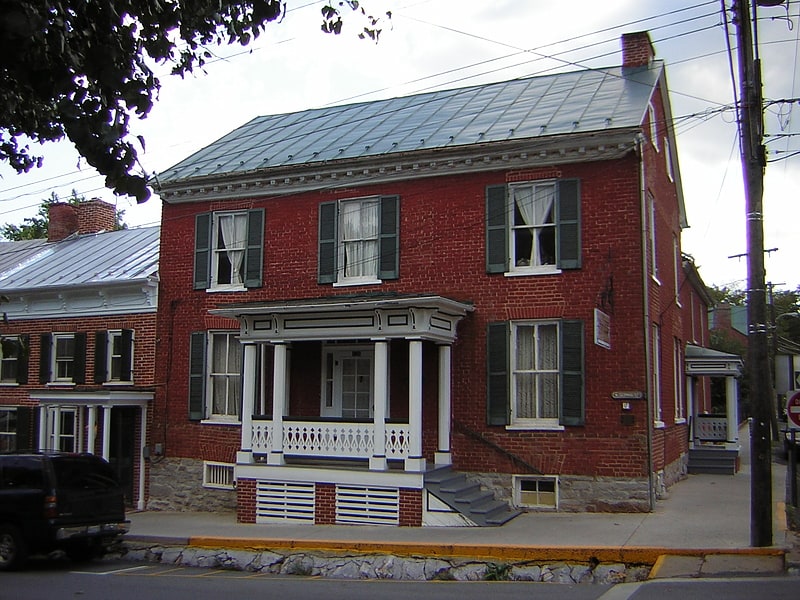
Building in Shepherdstown, West Virginia. The Conrad Shindler House is a historic building, now home to the George Tyler Moore Center for the Study of the Civil War, in Shepherdstown, West Virginia.[6]
Morgan-Bedinger-Dandridge House

Historical place in Jefferson County, West Virginia. The Morgan-Bedinger-Dandridge House — first known as Poplar Grove, then Rosebrake — is part of a group of structures affiliated with the Morgan's Grove rural historic district near Shepherdstown, West Virginia. The property was known as "Poplar Grove" until 1877.[7]